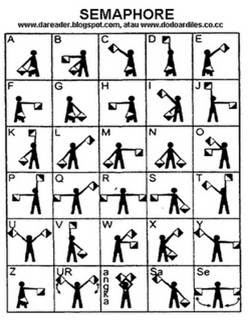

For example, the UK and Sweden adopted systems of shuttered panels (in contradiction to the Chappe brothers' contention that angled rods are more visible). Many national services adopted signaling systems different from the Chappe system. Other Systemsįrom 1803 on, the French also used the 3-arm Depillon semaphore at coastal locations to provide warning of British incursions. A rate of 2-3 symbols per minute was typical. In this manner, each symbol could propagate down the line as quickly as operators could successfully copy it, with acknowledgement and flow control built into the protocol. Step 2, movement 3 (completion): The cross bar was turned to a vertical or horizontal position, indicating the end of a cycle.The operator then waited for the downline station to copy it. Step 1, movement 2 (transmission): The indicator arms were positioned for the current symbol.The crossbar was then moved into position for the current symbol. Step 1, movement 1 (setup): The indicator arms were turned to align with the cross bar, forming a non-symbol.Symbols were transmitted in cycles of "2 steps and 3 movements." The revised Chappe system of 1795 provided not only a set of codes but also an operational protocol intended to maximize line throughput.
#Semaphor hill code#
The Chappes' corporation used a code that took 92 of the basic symbols two at a time to yield 8,464 coded words and phrases. To speed up transmission and to provide some semblance of security, a code book was developed for use with semaphore lines. Night operation with lamps on the arms was unsuccessful. Each of the two 2-metre-long arms could display seven positions, and the 4.6-metre-long cross bar connecting the two arms could display four different angles, for a total of 196 symbols (7×7×4).

With counterweights (named forks) on the arms, the Chappe system was controlled by only two handles and was mechanically simple and reasonably robust. Their semaphore was composed of two black movable wooden arms, connected by a cross bar the positions of all three of these components together indicated an alphabetic letter. The Chappe brothers determined by experiment that it was easier to see the angle of a rod than to see the presence or absence of a panel. Modern derivatives of the semaphore system include flag semaphore (a flag relay system) and the heliograph (optical telegraphy using mirror-directed sunlight reflections).ĭiagram showing the Chappe system, as used simply for signalling letters and numbers (though it could also be used in an encoded form). The line-of-sight distance between relay stations was limited by geography and weather, and prevented the optical telegraph from crossing wide expanses of water, unless a convenient island could be used for a relay station. Semaphore lines were a precursor of the electrical telegraph, which would replace them half a century later, and would also be cheaper, faster, and more private. This system was much faster than post riders for conveying a message over long distances, and also had cheaper long-term operating costs, once constructed. They would pass the message on to the next tower. Operators at each tower would watch the neighboring tower through a spyglass, and when the semaphore arms began to move spelling out a message. Lines of relay towers with a semaphore rig at the top were built within line-of-sight of each other, at separations of 5 to 20 miles. The most widely used system was invented in 1792 in France by Claude Chappe, and was popular in the late eighteenth to early nineteenth centuries. Information is encoded by the position of the mechanical elements it is read when the shutter is in a fixed position. A semaphore telegraph is a system of conveying information by means of visual signals, using towers with pivoting shutters, also known as blades or paddles.


 0 kommentar(er)
0 kommentar(er)
